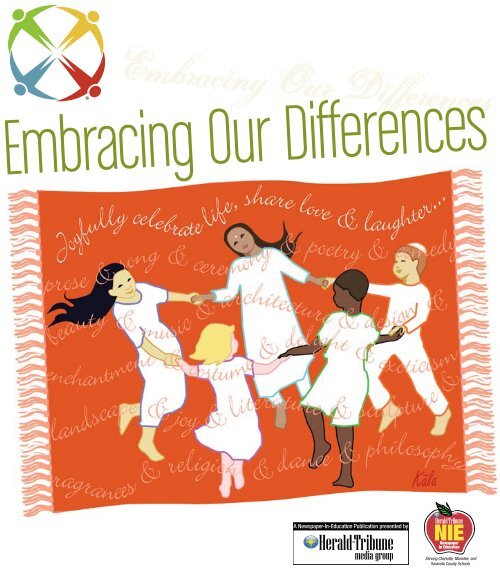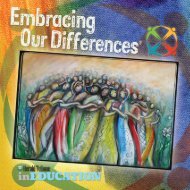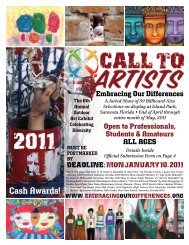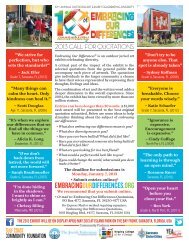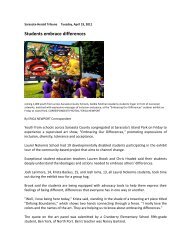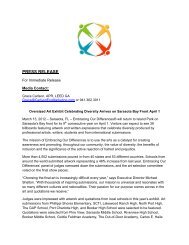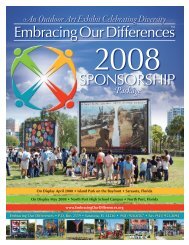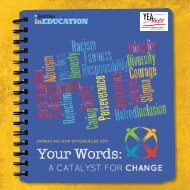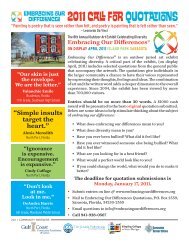Diversity - Embracing Our Differences
Diversity - Embracing Our Differences
Diversity - Embracing Our Differences
Create successful ePaper yourself
Turn your PDF publications into a flip-book with our unique Google optimized e-Paper software.
<strong>Embracing</strong><strong>Our</strong> <strong>Differences</strong><br />
<strong>Embracing</strong> <strong>Our</strong> <strong>Differences</strong>
You must be the change<br />
you wish to see in the world. –<br />
Mahatma Gandhi<br />
ABOUT THE ARTWORK:<br />
Acknowledge and Embrace” by Rachel Robbins, Ringling College<br />
of Art + Design, Sarasota, Florida, Faculty: Dee Hood<br />
ARTIST STATEMENT: “Looking at ourselves from a different perspective, or from a larger<br />
scale, the viewer may think about humanity and their role within it. I used the earth<br />
as a symbol to represent one common trait. The text is used throughout the piece to<br />
create rhythm as well as to express the message.”<br />
Contents<br />
[3 What is “<strong>Embracing</strong> <strong>Our</strong> <strong>Differences</strong>?”]<br />
[4 Know What You Are Talking About] [5<br />
Erase Racism: Jim Crow Laws] [6 Building<br />
Bridges] [7 Neighborhood Tally] [8 Art<br />
Around the World] [10 Spread the Word] [11<br />
Make A Difference] [12 Resource Equality]<br />
[13 The Changing Face of America] [14<br />
Images of Love] [15 Resources]<br />
02<br />
EMBRACING OUR DIFFERENCES<br />
Dear Reader,<br />
<strong>Embracing</strong> <strong>Our</strong> <strong>Differences</strong> ® is a juried outdoor art exhibition entering<br />
its fifth year. <strong>Our</strong> mission is to use art as a catalyst for creating awareness<br />
and promoting, throughout our community, the value of diversity,<br />
the benefits of inclusion and the significance of the active rejection of<br />
hatred and prejudice. The exhibit will contain 39 billboard-sized artworks,<br />
each accompanied by an inspirational quotation.<br />
Since 2004, the <strong>Embracing</strong> <strong>Our</strong> <strong>Differences</strong> ® exhibit has been viewed<br />
by more than 400,000 visitors. Last year, almost 21,000 students and<br />
teachers attended the exhibit – free of charge thanks to our School Bus<br />
Program – for a firsthand observation and discussion concerning the<br />
importance of diversity in our lives.<br />
We began this project because hate crimes are<br />
such a critical issue in our society and we hoped<br />
our message would speak to people. We did<br />
not anticipate the overwhelming and positive<br />
response that we received from the general<br />
public. Nor did we anticipate the profound<br />
effect it would have on students and the strong<br />
interest we would have from educators.<br />
This year we received more than 1,600 entries from around the<br />
world. Almost half of the 39 works of art selected for the final exhibition<br />
are from students. Due to increased funding, we will be able to<br />
increase the number of visiting students by 25 percent; we have also<br />
been able to provide educators with more materials for a diversity curriculum.<br />
Newspapers in Education is an essential part of this curriculum.<br />
We invite you to participate in creating a society that is more inclusive<br />
for all. Please bring your friends and family members and visit this free<br />
exhibition. Tell others about your experience. Thank the educators who<br />
have undertaken the field trips and created programs on diversity and<br />
inclusivity for your children. Help your children to be the change you<br />
wish to see in the world!<br />
Michael Shelton, Executive Director<br />
<strong>Embracing</strong> <strong>Our</strong> <strong>Differences</strong><br />
www.embracingourdifferences.org<br />
ON THE COVER<br />
“Joyfully Celebrate Life,” by Kala, Yonkers, New York.<br />
ARTIST STATEMENT: “Five children dance in the warp of a magic carpet.<br />
Each child is a beautiful color, separate from the rest. The weft that unites<br />
them are the threads that run through all cultures, make us one while<br />
preciously unique at the same time. To embrace our differences is to enter<br />
into endless enchantment and unimagined experiences.”<br />
A Herald-Tribune Media Group Newspaper-in-Education Publication
What is<br />
WHAT IS<strong>Embracing</strong> <strong>Our</strong> <strong>Differences</strong>?<br />
WHAT IS OUR<br />
<strong>Embracing</strong> <strong>Our</strong> <strong>Differences</strong>?<br />
EMBRACING OUR DIFFERENCES?<br />
OUR DIFFERENCES?<br />
E<br />
mbracing our <strong>Differences</strong> is an outdoor art exhibit intended to<br />
demonstrate, in a positive way, that diversity enriches our lives;<br />
that respect for differences in our thoughts and beliefs elevates the<br />
human experience; and that the active rejection of prejudice and<br />
hatred enhances our own freedom.<br />
The exhibit is being used to open up dialogue and understanding in our community.<br />
It features 39 billboard size images created by professional artists, art<br />
students, and school children from Florida, around the country and the world.<br />
Their creations reflect their interpretation of our message: “enriching lives<br />
through diversity.”<br />
<strong>Embracing</strong> <strong>Our</strong> <strong>Differences</strong> grew from the traveling exhibition, “Coexistence”<br />
produced by the Museum on the Seam, located at the Damascus Gate at the<br />
entrance to the old city of Jerusalem. That theme, coexistence, is also a basis<br />
of this current exhibition. Take your time, look at the images and reflect on the<br />
theme of diversity and of coexistence:<br />
• Think about what diversity and coexistence mean to you.<br />
• Explain how the word diversity and the images and text will<br />
influence your life.<br />
• Explain the difference between coexistence and tolerance.<br />
• Describe the difference between respect and tolerance.<br />
Where does coexistence fit?<br />
Discuss This!<br />
DISCUSS THIS!<br />
Discuss the following questions:<br />
• Who is reflected (or not) in your<br />
life, school and community?<br />
• Why is coexistence and diversity<br />
important?<br />
• What happens when coexistence<br />
exists, and when it does not?<br />
• What types of things cause conflict<br />
between neighbors?<br />
Here are some discussion questions<br />
that you can use to open up dialog<br />
with your family, friends, and at<br />
your school:<br />
• Who are the artists? Where do they come<br />
from? What motivated their piece?<br />
• Why do you feel the quote was matched<br />
with the image?<br />
• How does the quote enrich the image?<br />
• What types of artistic images have<br />
been created?<br />
• Choose an image from the exhibition, or<br />
within these pages, that you like the most<br />
and tell why.<br />
• Give the poster a title or a name.<br />
ABOUT THE ARTWORK:<br />
“<strong>Diversity</strong> Adds Up!” by Toby Thompson, Sarasota, Florida<br />
ARTIST STATEMENT: “I am an emotional and passionate artist that loves<br />
metaphors, color and typography as art forms.”<br />
There never were in the world two opinions<br />
alike, no more than two hairs or two grains,<br />
the most universal quality is diversity.<br />
– Michel de Montaigne, French Philosopher (1533-1592)<br />
• Chose a second image: What similarities<br />
are there to the first? What are some of<br />
the differences? How do they relate to<br />
each other?<br />
• Explain how these posters promote and<br />
can open a dialogue about diversity.<br />
• How do these images relate to the<br />
world today?<br />
• Using the theme of diversity and this<br />
series of posters, how can this exhibition<br />
help us change the ways we feel and<br />
think about issues?<br />
• Discuss things in your own community<br />
that separate and divide humans. What<br />
can be done to bring communities and<br />
humans together in a state of coexistence?<br />
• Choose an image from the exhibition,<br />
• How can these issues be resolved<br />
or within these pages: How does this<br />
peacefully?<br />
piece make you think about diversity<br />
and tolerance?<br />
A Herald-Tribune Media Group Newspaper-in-Education Publication EMBRACING OUR DIFFERENCES 03
KNOW WHAT YOU ARE<br />
TALKING ABOUT<br />
<strong>Diversity</strong> (di-VER-sit-ee) –The variety or<br />
difference between people or groups in<br />
a community.<br />
C<br />
elebration<br />
of diversity includes being different as an individual, recognizing<br />
that others are different from you, and appreciating the differences.<br />
America. The United States. The Melting Pot. Quilt of Many Colors.<br />
Land of Opportunity...<br />
The United States is one nation, but many different people.<br />
We are many different ages, we are many different colors. We speak different<br />
languages, we celebrate different holidays, we practice different religions. We live in<br />
big stone houses or tiny apartments. We are poor, rich and somewhere in-between.<br />
The differences among our people give our nation diversity unlike any other country<br />
in the world.<br />
DIVERSITY IS VARIETY.<br />
As people, we celebrate diversity. But at the same time, we often struggle to<br />
overcome the prejudices that come with these differences.<br />
This special section will explore the issues that arise for us all in this diverse,<br />
multicultural society. When you understand differences better, you’ll see there are<br />
countless opportunities in your life to celebrate diversity.<br />
Newspaper Activity<br />
Know What You’re Talking About<br />
Define the following words. Then look for articles in the Herald-Tribune<br />
that use these words. Clip the articles and compare and contrast the<br />
issues in the articles. (Answers, page 15)<br />
ABOUT THE ARTWORK:<br />
“Turn Your Back On Racism” by Kayla Cloonan, 12th Grade,<br />
Port Charlotte High School, Port Charlotte, Florida Teacher: Tiffany Coffey<br />
ARTIST STATEMENT: “My piece is layered with meaning: equality,<br />
acceptance and friendship. We should judge people for the<br />
uniqueness of their personalities and the quality of their minds,<br />
instead of their appearances.”<br />
Where bigotry rejects and hate divides;<br />
hope heals and love conquers.<br />
– Grace Carlson, Champion for Kids & the Environment, Sarasota, Florida<br />
HOW DIVERSE ARE WE?<br />
These figures are from the United States Census Bureau,<br />
Population Estimates Program, for the year 2005.<br />
Race Total Percent<br />
Total Population 293,655.4 100.0%<br />
One race 289.216.7 98.5%<br />
White 236,057.8 80.4%<br />
Black/African American 37,502.3 12.8%<br />
American Indian<br />
and Alaska Native 2,824.8 1.0%<br />
1. Prejudice<br />
4. Immigration<br />
7. Multicultural<br />
Asian 12,326,2 4.2%<br />
2. Tolerance<br />
3. Discrimination<br />
5. Melting Pot<br />
6. Assimilation<br />
8. Affirmative Action<br />
9. Stereotypes<br />
Native Hawaiian<br />
and Other Pacific Islander 505.6 0.2%<br />
Two or more races 4,438.8 1.5%<br />
FLORIDA STATE CHARACTER EDUCATION MANDATE: Statute 1003.42 (s)<br />
(For description see page 15.)<br />
04<br />
EMBRACING OUR DIFFERENCES<br />
Hispanic or Latino<br />
(any race) 41,322. 14.1%<br />
White alone<br />
not Hispanic or Latino 197,840.8 67.4%<br />
A Herald-Tribune Media Group Newspaper-in-Education Publication
ERASE RACISM<br />
J<br />
im Crow was not a person, yet affected the<br />
lives of millions of people. Named after a popular<br />
19th-century minstrel song that stereotyped African<br />
Americans, “Jim Crow” came to personify the system<br />
of government-sanctioned racial oppression and segregation<br />
in the United States.<br />
Jim Crow laws were explicit and often highly specific in imposing second-class<br />
citizenship on African Americans and other non-whites. Yet Jim<br />
Crow customs could be even more pervasive than laws. Black men, for<br />
example, knew that avoiding physical contact with white women was not<br />
sufficient; the mere act of making eye contact, or offering to light a cigarette,<br />
was considered anathema by whites.<br />
Beyond the ever-volatile theme of interracial romance, blacks endured<br />
many other indignities on a daily basis: they were expected to address<br />
whites as “Mr.” or “Mrs.” while whites addressed blacks by their first<br />
names, “boy” or “girl,” or “nigger.” Depending upon the specifics and<br />
circumstances, violation of the unwritten rules could easily result in insult,<br />
beating, or lynching.<br />
Jim Crow laws, and many of its customs, are no longer a part of<br />
American society. Many African Americans – and members of other racial<br />
and ethnic groups – have achieved success through opportunities their<br />
parents and grandparents could hardly have imagined.<br />
Yet the legacy of Jim Crow is a powerful one. Despite decades of progress<br />
and equality in the eyes of the law, few would argue that ours is a<br />
truly color-blind society. The many differences between now and the Jim<br />
Crow era are striking; in some cases, so are the parallels.<br />
A Brief History of Jim Crow<br />
Promises Betrayed (1865–1896)<br />
After the Civil War, African Americans<br />
were denied political and civil rights,<br />
and the right to own land. They were<br />
subjected to disfranchisement and segregation<br />
enforced by law, as well as lynchings,<br />
beatings and burnings. African<br />
Americans created their own political,<br />
economic and educational opportunities,<br />
which included the founding of<br />
Tuskegee Institute and the all-black<br />
town of Mount Bayou, Mississippi. In<br />
1896, the Supreme Court upheld the<br />
doctrine of “separate but equal.”<br />
Fighting Back (1896–1917)<br />
Denied their rights, blacks created<br />
their own churches, schools, businesses,<br />
and clubs. Despite resistance and riots,<br />
Charlotte Hawkins Brown built quality<br />
schools while black musicians created the<br />
blues and jazz. The National Association<br />
for the Advancement of Colored People<br />
(NAACP), an interracial civil rights organization,<br />
was founded to help fight for<br />
black rights and against segregation in<br />
the federal government.<br />
Don’t Shout Too Soon (1918–1940)<br />
Race riots roared as African American<br />
soldiers returned from WWI. The white<br />
president of Fisk University was ousted<br />
due to black students striking. Hundreds<br />
of thousands of blacks left the South,<br />
including musicians and writers who<br />
gave birth to the Harlem Renaissance.<br />
Sharecroppers, aided by Communist<br />
organizers, began to oppose their landlords.<br />
The NAACP began to challenge<br />
Jim Crow in the courts.<br />
Terror and Triumph (1940–1954)<br />
After WWII, returning African American<br />
soldiers were unwilling to resume life in<br />
segregated America. The Supreme Court<br />
made all-white political primaries illegal<br />
and blacks organized voter registration<br />
drives. President Harry Truman involved<br />
the federal government in civil rights<br />
issues. A student strike against unequal<br />
schools in Farmville, Virginia, became<br />
one of five cases that the U.S. Supreme<br />
Court reviewed when it ruled segregation<br />
unconstitutional in May of 1954 in<br />
Brown v. Board of Education.<br />
– From www.pbs.org/wnet/jimcrow<br />
Erase Racism<br />
ABOUT THE ARTWORK:<br />
“One Heart” by Rebekah Fazioli, 9th Grade, Bayshore High School,<br />
Bradenton, Florida, Teacher: Kathy Cocciolone<br />
ARTIST STATEMENT: “When you put the black and white hands together to make the<br />
heart, it says we can embrace our differences and love... no matter what we are.”<br />
If people believe in the power of love instead of<br />
the love of power, world peace is possible.<br />
– Melody Mishkin, 8th Grade, Pine View School, Sarasota, Florida<br />
Newspaper Activity<br />
Citizen’s Rights<br />
Jim Crow laws were a clear violation of the rights of American<br />
citizens. Similarly, in Europe, Hitler’s actions after World War I<br />
were a clear violation of the rights of Jewish citizens. Search<br />
the Herald-Tribune for examples of an elected government<br />
violating the rights of its citizens. Read the article. Think about<br />
the repercussions of such an action. In a brief essay, explain the<br />
main points of the article and how you feel it violates citizen’s<br />
rights. Share this information with your class.<br />
SUNSHINE STATE STANDARDS: LA.A.1.2-4; LA.A.2.2-4; LA.B.2.2-4; LA.C.3.2-4; LA.E.2.2-4;<br />
SS.A.3.2-4; SS.C.1.2-4; SS.C.2.2-4; SS.D.2.2-4<br />
A Herald-Tribune Media Group Newspaper-in-Education Publication EMBRACING OUR DIFFERENCES 05
BUILDING BRIDGES<br />
T<br />
hroughout history, there are<br />
hundreds of examples of nations<br />
battling their neighbors over land,<br />
beliefs, or even life style. Research<br />
the turmoil in one of the following<br />
countries in your school media center<br />
or local library: Ireland South Africa, Israel, Iraq,<br />
Vietnam, United States of America, Sierra Leone,<br />
Bosnia-Serbia, Yugoslavia, Iran, Korea, Germany,<br />
Rwanda, Somalia, Lebanon, Ukraine, Guatemala,<br />
Chile, El Salvador, Uganda, Nicaragua, Cambodia,<br />
Kosovo, Tibet, East Timor, Republic of the Congo,<br />
and Poland.<br />
Israel has adopted several educational programs<br />
promoting coexistence. Although there are many<br />
differences between neighbors, in order to promote<br />
coexistence, one must embrace the similarities and<br />
celebrate the differences in culture. Here are some<br />
“rules of the road” when building bridges and developing<br />
programs to foster coexistence.<br />
• Recognize the importance of language:<br />
Language is at the base of one’s national identity.<br />
Just as language creates bridges and ties between<br />
people, it can be an obstacle to contact. Language<br />
differences must be taken into account. On the other<br />
hand, the study of language can be used as a bridge<br />
for coexistence.<br />
• Coexistence can be an unstated goal: The<br />
premise behind the experiential programs is to<br />
engage parties in joint activities that everyone<br />
enjoys. The close proximity will, over time,<br />
promote coexistence.<br />
• Teachers and administrators must support<br />
projects run in their schools: The principal must<br />
demonstrate a clear interest in the program to insure<br />
it is viewed as an important component of the curriculum.<br />
Similarly, teachers’ support is vital to encouraging<br />
student participation and supporting the changes<br />
resulting from the program.<br />
• Parents should be involved: The support and<br />
cooperation of parents are essential. Projects should<br />
be viewed as an opportunity to spread the message<br />
of coexistence beyond the classroom and into homes<br />
and communities. Joint activities that involve the<br />
communities and parents foster mutual tolerance.<br />
• Preparation is needed prior to interactions:<br />
Before engaging in any joint activities, it is important<br />
to spend time preparing for the meetings. Students<br />
and teachers should be intimately involved in planning<br />
the interactions. Sessions to examine stereotyped<br />
thinking, generalizations and prejudice are<br />
important to prepare groups for encounters. The<br />
establishment in advance of clear rules also makes<br />
meetings work more harmoniously.<br />
• Promoting coexistence is facilitated by government<br />
support: The Israeli Ministry of Education<br />
provides an example of how a governmental body<br />
can play an important role in introducing coexistence<br />
projects into the schools.<br />
• Careful student selection enhances prospects<br />
for success: Highly motivated students will influence<br />
their peers.<br />
• It is important for projects to be consistent<br />
and ongoing: Ongoing multiyear programs reinforce<br />
a consistent commitment to improving crosscultural<br />
relations.<br />
– Source: The American-Israeli Cooperative Enterprise<br />
at www.jewishvirtuallibrary.org<br />
Activity<br />
Talk Is Cheap<br />
ABOUT THE ARTWORK:<br />
“Awesome” by Sarah Carr, 12th Grade, Port Charlotte High School, Port Charlotte,<br />
Florida , Teacher: Tiffany Coffey<br />
ARTIST STATEMENT: “A lot of people walk around thinking they are totally separate<br />
from each other. I believe we are all together and there to help one another. I explored<br />
the idea of six people handcuffed to each other, forced to be together - in hopes they<br />
will discover they are more alike than they imagine.”<br />
06<br />
EMBRACING OUR DIFFERENCES<br />
How do we talk about people when<br />
they are not around?<br />
Write down how you think<br />
or talk about the following:<br />
My School<br />
My Class<br />
My Neighborhood<br />
With My Friends<br />
In the World<br />
How can you change the way you talk about these<br />
areas to foster acceptance of diversity?<br />
A Question of Unity. Just because I’m a different race, why do you hate me? Just because I’m young, why do you<br />
not trust me? Just because I’m a little bit overweight, why do you taunt me? Just because I am different.<br />
– Derrek Gunnells, 8th Grade, Booker Middle School, Sarasota, Florida<br />
A Herald-Tribune Media Group Newspaper-in-Education Publication
ABOUT THE ARTWORK:<br />
“We All Connect” by Brittany Targaszewski, 5th Grade, Fruitville<br />
Elemantary School, Sarasota, Florida, Teacher: Alma Vega<br />
ARTIST STATEMENT: “Each unique part of the faces represents a different<br />
person and race. The can all be drawn together to make one face of many<br />
colors. Even though we are all different, when you combine our parts, we<br />
are the same - human. If we share our personalities we can find some way<br />
to connect to one another.”<br />
Friends celebrate the things they<br />
have in common and delight in the<br />
things that make them different.<br />
– Unknown<br />
Neighborhood Tally<br />
Check all of the boxes that apply<br />
for each of the statements below<br />
FEMALE<br />
MALE<br />
ELDERLY<br />
ASIAN AMERICAN<br />
AFRICAN AMERICAN<br />
HISPANIC<br />
NATIVE AMERICAN<br />
WHITE<br />
YOUNG<br />
OLD<br />
1. I am<br />
2. My neighborhood is<br />
3. My school is<br />
4. My friends are<br />
5. People who come to my house are<br />
6. My teacher is<br />
7. <strong>Our</strong> principal is<br />
8. <strong>Our</strong> school superintendent is<br />
9. The doctor I visited last was<br />
10. WE shop at a store run by<br />
11. The cashiers are<br />
12. <strong>Our</strong> mayor is<br />
13. <strong>Our</strong> city council is<br />
14. <strong>Our</strong> bank manager is<br />
15. Most police officers are<br />
16. <strong>Our</strong> mail carrier is<br />
17. <strong>Our</strong> repair people are<br />
A Herald-Tribune Media Group Newspaper-in-Education Publication EMBRACING OUR DIFFERENCES 07
Art Around The World<br />
ART AROUND THE WORLD<br />
4<br />
1<br />
<br />
<br />
<br />
<br />
“Similar” by Mirek Antoniewicz Wroclaw, Poland<br />
<br />
<br />
“Black & White Tourists Visit Egypt”<br />
by Margo Cormier Splane Ontario, Canada<br />
<br />
5<br />
“A Heart Full of Love”<br />
by Ching Ching, Teoh Georgetown, Malaysia<br />
2<br />
“Cultural <strong>Diversity</strong>”<br />
by Jane Tagg Egremont, England<br />
The first day or so, we all pointed to our countries. The third or<br />
fourth day, we were pointing to our countries. By the fifth day,<br />
we were aware of only one Earth. – Sultan Bin Salman al Saud, Saudi Astronaut<br />
6<br />
“Every Soldier Belongs To A Family”<br />
by Mohammad Wahiduzzaman Dhaka, Bangladesh<br />
“The World’s Children are One Loving<br />
Family” by Luo Sihang 4th Grade, Xiamen Datong<br />
Elementary School Xiamen, China (Sarasota Sister City)<br />
Teacher: Luo Ping<br />
3<br />
Art Around<br />
The World<br />
ACTIVITY Letter Writing<br />
All the artists and images here represent<br />
a different culture than ours.<br />
What are the similarities of all these images?<br />
What values are they exploring?<br />
Choose and image and write a letter to the artist.<br />
FLORIDA STATE CHARACTER EDUCATION MANDATE: Statute 1003.42 (s)<br />
(For description see page 15.)<br />
“A Man’s A Man For A’ That” by David Ewles<br />
Dunfermline, Scotland (Sarasota Sister City)<br />
08 EMBRACING OUR DIFFERENCES<br />
A Herald-Tribune Media Group Newspaper-in-Education Publication<br />
A Herald-Tribune Media Group Newspaper-in-Education Publication EMBRACING OUR DIFFERENCES 09<br />
7
Spread The Word<br />
Spread The Word<br />
Here’s an art activity that can help spread the word about celebrating diversity.<br />
USING THIS SPACE AND THE NEWSPAPER,<br />
make a collage artwork to show diversity, liberty,<br />
freedom or prejudice — or a combination<br />
of them all!<br />
USE PHOTOGRAPHS OR CARTOONS you may<br />
find in the paper, headlines, words or images<br />
from ads. Remember that one image should<br />
draw your eye into the collage, so make sure<br />
you have one that is dramatic. Use colored<br />
crayons or markers to highlight parts of your<br />
artwork, if you like. If you need more space,<br />
use a separate sheet of paper.<br />
“SIGN” YOUR COLLAGE BY PICKING AN IMAGE<br />
OR WORD out of the paper that could be a<br />
symbol of you. Paste it in the lower right corner.<br />
When you have finished, mount your collage<br />
on construction paper and display them<br />
in your classroom or a school hallway.<br />
10<br />
EMBRACING OUR DIFFERENCES<br />
A Herald-Tribune Media Group Newspaper-in-Education Publication
MAKE A DIFFERENCE<br />
ow can you help to promote diversity, foster coexistence<br />
and help make the world a better place? Here are suggestions<br />
of websites that will help you make a difference in your<br />
life, your community, and the world at large.<br />
Suggestion? Begin with the organization or issue that matters<br />
most to you, that touches you in some way: and then, start small. As<br />
you go along, your contribution may grow larger and larger.<br />
H<br />
www.peachjam.org<br />
The mission of the PeaceJam Foundation is to create a new generation of young<br />
leaders committed to positive change in themselves, their communities and the<br />
world through the inspiration of Nobel Peace Laureates.<br />
Make A Difference<br />
www.tolerance.org<br />
TONS of lessons and ideas on how to promote acceptance. Tolerance.org is a<br />
principal online destination for people interested in dismantling bigotry and creating,<br />
in hate’s stead, communities that value diversity. (Read more about how we<br />
define “tolerance.”)<br />
http://www.freerice.com<br />
FreeRice is a sister site of the world poverty site, Poverty.com. FreeRice has<br />
two goals: Provide English vocabulary to everyone for free and help end world<br />
hunger by providing rice to hungry people for free. This is made possible by the<br />
sponsors who advertise on the site.<br />
http://www.humanityquest.com/topic/Index.<br />
asp?theme1=tolerance<br />
HumanityQuest.com is building a community and portal for the exploration of<br />
human spirits, values, attitudes, principles and emotions. We thematically explore<br />
a growing list of over 500 human values, using in person and online study<br />
groups, discussions groups, creative arts activities, resource links, and computer<br />
technology. Be sure to send feedback and suggestions about this site to us. We<br />
enjoy hearing from you.<br />
ABOUT THE ARTWORK<br />
“Peace Train” by Todd Wennberg, 11th Grade, Bayshore High School,<br />
Bradenton, Florida, Teacher: Kathy Cocciolone<br />
ARTIST STATEMENT: “I referred to “The Little Engine Who Could” because it is<br />
a message of accomplishment that is taught to us at a very young age. I want<br />
everyone to realize that they can accomplish anything they set their mind to.<br />
Maybe we will all set our minds on peace and tolerance.”<br />
We need diversity of thought in the world<br />
to face the new challenges.<br />
– Tim Berners-Lee, British Physicist<br />
http://stopbullyingnow.hrsa.gov/<br />
Stop bullying in your elementary and middle school.<br />
http://www.tolerance.org/teens/<br />
?source=redirect&url=mixitup#<br />
Mix It Up at Lunch Day — to be held on November each year — is a simple call<br />
to action: take a new seat in the cafeteria. By making the move, students can<br />
cross the lines of division, meet new people and make new friends.<br />
http://www.oneisgreaterthannone.org/home.asp<br />
For months, a group of 14 year-old girls talked about starting a charity. These<br />
eight girls were determined to make a difference in someone’s life, but never<br />
seemed to agree on “who, what, where or how”. They did however have the<br />
answer to the most important question. “Why?”<br />
http://www.becauseitmatters.net/<br />
Research tells us that those actions would make us feel good. And, what’s<br />
equally important, when we feel good we extend those good feelings to the next<br />
person we encounter. When we communicate in a more respectful and effective<br />
way, our brain chemistry signals us to feel better about the world around<br />
us. When we feel better about the world around us, we pass it along. We pay it<br />
forward. <strong>Our</strong> quality of life is improved.<br />
http://www.nothingbutnets.net/<br />
Nothing But Nets is a grassroots campaign to save lives by preventing malaria,<br />
a leading killer of children in Africa. While the UN Foundation has been working<br />
with the UN to fight malaria for years, it was a column that Rick Reilly wrote<br />
about malaria in Sports Illustrated, challenging each of his readers to donate<br />
at least $10 for the purchase of an anti-malaria bed nets -- and the incredible<br />
response from thousands of Americans across the country -- that led to the creation<br />
the Nothing But Nets campaign.<br />
http://www.invisiblechildren.com/<br />
Motivated by the unseen war in Northern Uganda, Invisible Children was created<br />
by three young filmmakers with a singular mission: To use the power of stories<br />
to change lives around the world.<br />
http://www.youthnoise.org<br />
Youth Noise is a youth-led online program dedicated to inspire, connect and<br />
empower youth everywhere.<br />
http://www.dosomething.org<br />
This organization sponsors youth-led community change through service learning.<br />
A Herald-Tribune Media Group Newspaper-in-Education Publication EMBRACING OUR DIFFERENCES 11
esource Equality<br />
RESOURCE<br />
EQUALITY<br />
FOOD FOR THOUGHT<br />
Food Security: a situation that exists when all people, at all time, have<br />
physical, social and economic access to sufficient, safe and nutritious food<br />
which meets their dietary needs and food preferences for an active and<br />
healthy life.<br />
Think About It:<br />
• Each day, 25,000 people die of hunger<br />
• In developing countries, 777 million people do not have access<br />
to sufficient and adequate food.<br />
• In countries in transition, 27 million people suffer from undernourishment<br />
and 11 million people are undernourished in industrialized countries.<br />
• Approximately 70 percent of all available water is used for irrigation.<br />
WATER FOR LIFE<br />
According to the United Nations, “having access to safe and sufficient<br />
water and sanitation are now recognized as basic human rights. Being able<br />
to wash one’s hands and drink clean water can have a major impact on<br />
family hygiene and health. Women play an especially important role in this<br />
process. Because people who are poor are most likely to get sick, and ill<br />
health perpetuates poverty, it triggers a vicious cycle.”<br />
Think About It:<br />
• 1 billion people lack access to improved water supply.<br />
• 2.4 billion people lack access to improved sanitation.<br />
• Every day, diarrhoeal diseases from easily preventable causes claim the lives<br />
of approximately 5000 young children throughout the world.<br />
• With simple hygiene measures such as washing hands after using the<br />
toilet or before preparing food, most of these deaths are preventable.<br />
ENERGY SUSTAINS<br />
Energy is central to sustainable development and poverty reduction<br />
efforts. It affects all aspects of development – social, economic, and environmental<br />
– including livelihoods, access to water, agricultural productivity,<br />
health, population levels, education, and gender-related issues.<br />
Think About it:<br />
• About two billion people have no access to electricity at all.<br />
• About one billion people use electricity from uneconomic sources<br />
• Some two and one-half billion people in developing countries, mainly in<br />
rural areas, have little access to commercial energy services.<br />
• More than two million children died from acute respiratory disease in<br />
2000; 60 percent of those deaths were associated with indoor air pollution<br />
and other environmental factors.<br />
12<br />
EMBRACING OUR DIFFERENCES<br />
ABOUT THE ARTWORK:<br />
“It’s Time To Clean Up <strong>Our</strong> Act With Mother Earth” by Brent DeLess,<br />
Parrish, Florida<br />
ARTIST STATEMENT: My artwork has helped me embrace, love and understand<br />
the planet we live on. I’ve been an active in groups like Save The Children, Children<br />
International, Arbor Society, Save the Wildlife and Save the Oceans.”<br />
We all live on the same planet, we need to keep<br />
it safe and clean, together.<br />
– Cydney Parker, 5th Grade, Willis Elementary School, Bradenton, Florida<br />
Newspaper Activities<br />
Exist Together<br />
An ecosystem is a living community of plant and animals that need<br />
each other to exist. An ecosystem is a dynamic complex of plant, animal<br />
and microorganism communities and their non-living environment<br />
interacting as a functional unit. We all live in an ecosystem. Look<br />
through the Herald-Tribune to find examples of things that you and<br />
your family need to exist in your community. Make a list of these things<br />
in a notebook. Next to each item, write down why you need this item<br />
to exist in your community. Share your information with your class.<br />
SUNSHINE STATE STANDARDS: LA.A.1.2-4; LA.B.2.2-4; LA.C.2.2-4; LA.C.3.2-4; SS.B.2.2-4; SC.F.1.2-4;<br />
SC.G.1.2-4<br />
Why Water<br />
A lot of water is wasted because so many people give little thought to<br />
where water comes from and where it goes after they use it. Yet less<br />
than one percent of Earth’s water is available for human consumption.<br />
Plus, there is no new water on earth.<br />
Look through the Herald-Tribune to find pictures of things that contain<br />
water. Create a collage with these items. You can also research<br />
the importance of water in our everyday lives. Write a well-developed<br />
paragraph discussing the images you find and the importance of<br />
water in our lives. Present your project to the class.<br />
SUNSHINE STATE STANDARDS: LA.A.2.2-4; LA.B.2.2-4; LA.C.1.2-4; LA.C.3.2-4; SC.D.1.2-4; SC.D.1.2-<br />
4; SC.D.2.2-4; SC.F.1.2-4; SC.G.1.2-4; SS.B.2.2-4<br />
A Herald-Tribune Media Group Newspaper-in-Education Publication
THE CHANGING FACE OF AMERICA;<br />
WILL IT DIVIDE US OR UNITE US?<br />
an you imagine a country where all the<br />
people are the same color, come from<br />
the same place, practice the same traditions,<br />
hold the same religious beliefs and<br />
speak the same language?<br />
It would be a pretty ordinary place to live, wouldn’t it? Kind of dull<br />
and uninspiring?<br />
As one person put it, “When you are surrounded by sameness you<br />
get only variations of the same.” How true that is!<br />
America, of course, is anything but ordinary. It is a country full of<br />
diversity; a colorful, ever changing place to live and work.<br />
But some people don’t like diversity. Living with people of different<br />
racial, ethnic and cultural heritage often threatens them and makes<br />
them feel uncomfortable. And when these people let their fears take<br />
over, problems arise.<br />
You probably know by now that the United States has always had<br />
such problems. They have been worse at some times and in some<br />
places than others, but they are always present.<br />
That’s why it is important to take a long, hard look at our diverse<br />
nation and to understand the problems tat can divide us. Only then<br />
can we begin to work toward the solutions that will unite us.<br />
C<br />
Newspaper Activities<br />
We Are America<br />
• People are sometimes identified by race<br />
or ethnicity in newspaper stories. Go<br />
through your Herald-Tribune and mark<br />
such examples. Discuss why you think<br />
this is done.<br />
• Racial tensions can lead to violence. Look<br />
in the Herald-Tribune for stories and<br />
photographs about such violence. Discuss<br />
with your teacher and classmates some<br />
alternative actions when confronting racism<br />
and other problems.<br />
• Find examples in the Herald-Tribune of<br />
the positive effects of diversity. Clip one<br />
example and work with your classmates<br />
in designing a bulletin board display.<br />
ABOUT THE ARTWORK:<br />
“We Are America” by Nicolas F. Shi, Washington, DC<br />
ARTIST STATEMENT: “My work has been influenced by my Salvadorian upbringing, my<br />
Chinese heritage, and my formal education in the United States. In my paintings, I mix<br />
the boldness of contemporary American art with the harmony and simplicity of traditional<br />
Chinese paintings and the bright colors of Central America.”<br />
If some people were purple, and some people<br />
were green, who would we discriminat against?<br />
Sound ridiculous? Sound familiar?<br />
– Madeline Black, Center for Education, Montesorri School, Sarasota, Florida<br />
• Many movies deal with issues concerning<br />
diversity. The Joy Luck Club explored the<br />
lives of Asian immigrants in the United<br />
States. Many of director Spike Lee’s films<br />
deal with African-American issues. Check<br />
the movie listings and reviews in the<br />
Herald-Tribune’s Thursday Ticket section.<br />
Are there movies centered on cultural<br />
or racial themes? Discuss how movies<br />
reinforce or dispel racial or cultural stereotypes.<br />
Rents such a movie to show in<br />
class, then write a review about how it<br />
handles a diversity issue.<br />
FLORIDA SUNSHINE STATE STANDARDS: A.2.2.8; A.2.3.5; A.2.3.8; A.2.4.4; A.2.4.7; A.2.4.8<br />
• Daily newspapers, like the Herald-<br />
Tribune, reflect our multicultural society.<br />
Using items you clip from the newspaper,<br />
make a collage that illustrates how<br />
our varied cultures form a vital,<br />
vibrant society.<br />
• Watch the Herald-Tribune for examples<br />
of prejudice, stereotyping, discrimination<br />
and racism in action. What were the<br />
consequences of these actions. Share one<br />
example with the class.<br />
A Herald-Tribune Media Group Newspaper-in-Education Publication EMBRACING OUR DIFFERENCES 13
Images of Love<br />
This artwork, “The Love Series” is<br />
part of a larger body of work by the<br />
artist. The series gathers and depicts<br />
the world’s most inspiring peace<br />
activists, to show that the call for<br />
non-violence is being made from<br />
every corner of the world and from<br />
every generation.<br />
The Names<br />
of Love & Peace<br />
14<br />
Below are the names of these activists. Identify what<br />
the specific activities and activism that this person is<br />
known for, and why you think the artist chose them<br />
for the piece.<br />
(From Top, Left to Right)<br />
ROW 1<br />
Mahatma Gandhi<br />
The 14th Dalai Lama<br />
Anne Frank<br />
Cesar Chavez<br />
Nelson Mandela<br />
Aung San Suu Kyi<br />
ROW 2<br />
Martin Luther King Jr.<br />
Mother Teresa<br />
Susan B. Anthony<br />
Bob Marley<br />
Wangari Maathai<br />
Harvey Milk<br />
ROW 3<br />
Rigoberta Menchu Tum<br />
Thich Nhat Hanh<br />
Betty Friedan<br />
Coretta Scott King<br />
Cindy Sheehan<br />
Mother Jones<br />
ROW 4<br />
Elizabeth Cady Stanton<br />
Corbin Harney<br />
Rosa Parks<br />
Dana Reeves<br />
Henry David Thoreau<br />
Amy Goodman<br />
EMBRACING OUR DIFFERENCES<br />
ABOUT THE ARTWORK<br />
“The Love Series” by Autumn Rooney, Los Angeles, California<br />
ARTIST STATEMENT: “The average American is exposed to approximately 3,000 advertisements<br />
per day. What if we were exposed to 3,000 images and messages of love per day?”<br />
Leave a Legacy: Life your life, embracing the<br />
beauty in every person you meet. Your kindness<br />
will long be remembered and you will leave the<br />
world a better place. – Elizabeth C. Bertelsen, Sarasota, Florida<br />
Images of Love<br />
A Herald-Tribune Media Group Newspaper-in-Education Publication
RESOURCES<br />
Web sites<br />
Museum on the Seam<br />
www.coexistence.art.museum<br />
The Rise and Fall of Jim Crow<br />
www.pbs.org/wnet/jimcrow<br />
Book<br />
Respecting <strong>Our</strong> <strong>Differences</strong> - A Guide to Getting Along<br />
in a Changing World. By Lynn Duvall, published by Free<br />
Spirit Publishing.<br />
Magazine<br />
Teaching Tolerance Magazine - Published through the<br />
Southern Poverty Law Center, Montgomery, AL.<br />
Editor: Sara Bullard. A semi-annual magazine made<br />
available free to educators through a written request to:<br />
Teaching Tolerance, 400 Washington Avenue, Montgomery,<br />
AL. 36104.<br />
Other<br />
Anti-Bias Curriculum: Tools for Empowering Young<br />
Children. National Association for the Education of Young<br />
Children, Washington, D.C.<br />
150 Ways Teens Can Make A Difference: A Handbook<br />
for Action. By Marian Salzman and Teresa Reisgies with<br />
several thousand teenage contributors. Peterson’s Guides,<br />
Princeton, NJ.<br />
Erase the Hate. A special program produced by USA<br />
Network, hosted by Martha Plimpton, which focuses on<br />
young people concerned with bias, prejudice and hate.<br />
Prejudice: Answering Children’s Questions. An ABC<br />
Special, hosted by Peter Jennings. April 25, 1992.<br />
U.S. Census Bureau<br />
National Information Center for Children and Youth<br />
with Disabilities. Washington, D.C.<br />
National Council for the Social Studies. Washington, D.C.<br />
FLORIDA STATE CHARACTER EDUCATION MANDATE: Statute 1003.42 (s) A character-development<br />
program in the elementary schools, similar to Character First or<br />
Character Counts, which is secular in nature. Beginning in school year 2004-2005, the<br />
character-development program shall be required in kindergarten through grade<br />
12. Each district school board shall develop or adopt a curriculum for the characterdevelopment<br />
program that shall be submitted to the department for approval. The<br />
character-development curriculum shall stress the qualities of patriotism; responsibility;<br />
citizenship; kindness; respect for authority, life, liberty, and personal property;<br />
honesty; charity; self-control; racial, ethnic, and religious tolerance; and cooperation.<br />
ABOUT THE ARTWORK:<br />
“WHAT IF?” by Gregory Rumph, Sarasota, Florida<br />
ARTIST STATEMENT: “What if we embraced our differences as opposed to magnifying<br />
them? What if armies did not have to exist? The metaphor of warring guns becoming<br />
shaking hands speaks volumes.”<br />
I’ve never met a stranger.<br />
– Louis Armstrong, Jazz Trumpeter & Singer (1901-1971)<br />
DEFINITIONS From page 3<br />
1. Prejudice — A feeling for or against something without any good reason. For<br />
instance, if you believe that a certain group of people is inferior because of their<br />
religion, gender, physical characteristics or race, and you don’t really know anything<br />
about them, then you are prejudiced against them.<br />
2. Tolerance — Recognizing and respecting the beliefs and practices of others.<br />
3. Discrimination — Treating someone badly or unfairly because of the person’s<br />
race, age, sex or handicap.<br />
4. Immigration — Moving into a country where you and your family were not born<br />
and living in that country permanently.<br />
5. Melting Pot — Term often used to describe a place, like America, where people<br />
of different cultures, races and social groups come to live and work together. Today’s<br />
interest in diversity has made the term somewhat out of date. Instead of melting or<br />
blending together totally, different groups seek to keep their identities as they blend<br />
with other groups. America today is more like a quilt or a salad — each item recognized<br />
while being part of something bigger.<br />
6. Assimilation — When different cultural traditions blend until they are all very<br />
similar.<br />
7. Multicultural — Relating to, or designed for, different cultures.<br />
8. Affirmative Action — A government policy for creating special opportunities in<br />
jobs or education for people who might otherwise suffer from discrimination.<br />
9. Stereotypes — An opinion you form about ALL people in a group, based on<br />
things you have heard about SOME people in that category.<br />
A Herald-Tribune Media Group Newspaper-in-Education Publication EMBRACING OUR DIFFERENCES 15
<strong>Embracing</strong><strong>Our</strong> <strong>Differences</strong><br />
<strong>Embracing</strong> <strong>Our</strong> <strong>Differences</strong><br />
<strong>Embracing</strong> <strong>Our</strong> <strong>Differences</strong> ®<br />
2008 Outdoor Juried Art Exhibition<br />
39 Billboard Sized Works of Art with<br />
Companion Inspirational Quotes<br />
on <strong>Diversity</strong> and Inclusivity<br />
March 30 – May 4<br />
Sarasota’s Island Park Along the Bayfront<br />
<strong>Embracing</strong> <strong>Our</strong> <strong>Differences</strong> ® 2008 will visit:<br />
North Port, May 8 – May 31, 2008<br />
North Port High School<br />
For more information:<br />
www.embracingourdifferences.org<br />
ABOUT THE ARTWORK:<br />
“In The Long Run” by Katie Allen, 8th Grade, Pine View School,<br />
Osprey, Florida, Teacher: Mark Goebel<br />
ARTIST STATEMENT: “My piece says that people are like a race, and in life it<br />
doesn’t matter what type of race it is. What matters is how well you run the<br />
race, and live your life. The colors of the different lanes in the track, which<br />
are the colors of the rainbow, represent all the different kinds of people in<br />
the world and how they can all come together in harmony and make<br />
something great.”<br />
The human race is not the race of one human;<br />
it is a journey best traveled together.<br />
– Cindy Cuffage, North Port, Florida<br />
For additional information regarding the Herald-Tribune’s<br />
Newspaper in Education program, please contact Mary Charland,<br />
Newspaper In Education Manager at (941) 361-4545<br />
or email mary.charland@heraldtribune.com<br />
This publication was produced by the Custom<br />
Media Group of the Herald-Tribune Media Group.<br />
Editor: Emily Leinfuss Designer: Kim Collister<br />
16<br />
EMBRACING OUR DIFFERENCES<br />
www.nieonline.com/sarasota<br />
A Herald-Tribune Media Group Newspaper-in-Education Publication


